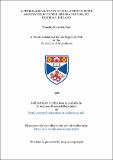Files in this item
A petrological study of the appenite suite associated with the Ardara pluton, Co. Donegal, Ireland
Item metadata
| dc.contributor.advisor | Stephens, W. E. | |
| dc.contributor.author | Yarr, Timothy Roderick | |
| dc.coverage.spatial | 382 p., 31 p. of plates. | en_US |
| dc.date.accessioned | 2018-07-19T09:35:40Z | |
| dc.date.available | 2018-07-19T09:35:40Z | |
| dc.date.issued | 1992-07 | |
| dc.identifier.uri | https://hdl.handle.net/10023/15565 | |
| dc.description.abstract | Appinites are enigmatic rocks commonly associated with major I-type plutons in the Caledonian orogen, a number of different models have been proposed for the origin of their parental magmas and unusual textural characteristics. The appinite cluster associated with the Ardara pluton has been studied using petrological techniques with the aim of understanding these features as well as their relationships to the main pluton. The approach of this study has been to select a few appinite bodies considered to be representative of the whole Ardara appinite suite, and to study each in detail in parallel with a limited study of the main pluton. The techniques adopted include field mapping, petrography, mineral chemistry, whole rock major and trace element geochemistry. The detailed aims were to constrain the origin of the magma, its emplacement history and differentiation, for each selected body. In one case (Portnoo) the role of fluids was investigated in detail using stable isotope geochemistry. The Ardara appinite suite comprises a wide variety of generally amphibole-rich rocks typically including hornblendite, meladiorite, diorite, granodiorite and granite. There is one case of cortlandtite. Most have evidence of a significant volatile phase at crystallisation. The intrusions display a wide range in form and emplacement mechanism and most were emplaced prior to, or coeval with, the diapiric granite pluton of Ardara. They have a history of tectonic control on emplacement and are associated with major shear zones acting as potential magma pathways. Mineral geobarometry and geothermometry indicate that the appinites crystallised at 5-8 kb, and selected mineral pairs equilibrated between 800 and 976°C. G1 and G2 of the Ardara pluton crystallised at 5 kb and amphibole-plagioclase equilibrated at around 800°C. These pressures are high if the appinites are high-level diatremes, and this apparent inconsistency is discussed. Variations in bulk geochemistry are considerable and attempts are made to model these as the products of crystal-liquid processes using mass balance major oxide and Rayleigh trace element techniques. The results tend to be dominated by solutions involving amphibole, other mafic minerals and plagioclase, although in many cases no satisfactory result was obtained which suggests that crystal fractionation is not always the sole cause of differentiation. Stable isotope studies of delta18O, delta13C and 5D from the appinites and country rocks at Portnoo indicate that the dominant fluid in this appinite was magmatic in origin, although crustal contamination had occurred, while 6D data also indicate role for meteoric fluids. The data show that fluids from the appinite penetrated the limestone aureole to about 40m. The compositional characteristics of the Ardara appinite suite support a model of derivation of a hydrous basic magma from a mantle source. These magmas undergo differentiation by multiple processes, including crystal-liquid fractionation, as well as contamination by crustal assimilation and possibly by other magmas. The source of G1 & G2 of the main pluton is relatively primitive and could be immature lower crust. It is possible to derive G1 from G2 by crystal fractionation, but probably not in situ. The central G3 granite was almost certainly derived from a distinct, rather more mature crustal source. | en_US |
| dc.language.iso | en | en_US |
| dc.publisher | University of St Andrews | |
| dc.subject.lcc | QE462.A6Y2 | |
| dc.subject.lcsh | Petrology | |
| dc.subject.lcsh | Aplite | |
| dc.title | A petrological study of the appenite suite associated with the Ardara pluton, Co. Donegal, Ireland | en_US |
| dc.type | Thesis | en_US |
| dc.contributor.sponsor | Department of Education for Northern Ireland | en_US |
| dc.type.qualificationlevel | Doctoral | en_US |
| dc.type.qualificationname | PhD Doctor of Philosophy | en_US |
| dc.publisher.institution | The University of St Andrews | en_US |
This item appears in the following Collection(s)
Items in the St Andrews Research Repository are protected by copyright, with all rights reserved, unless otherwise indicated.

